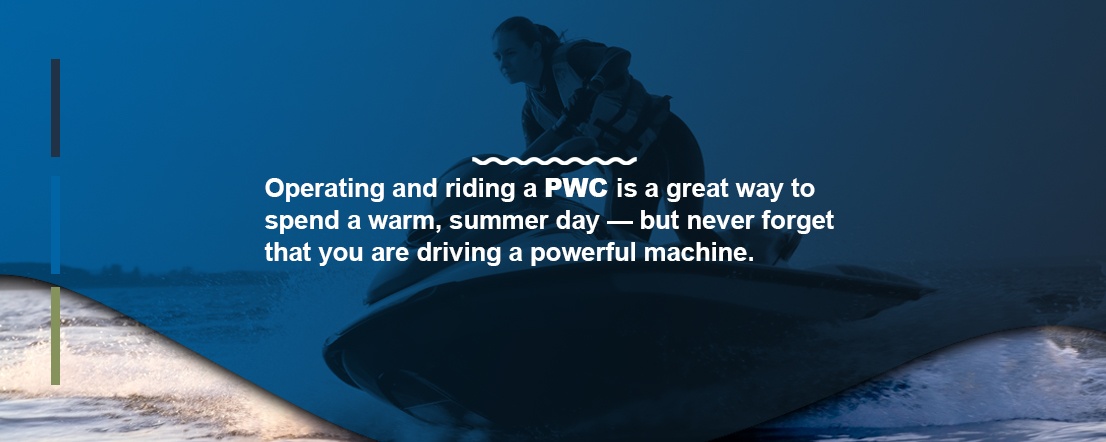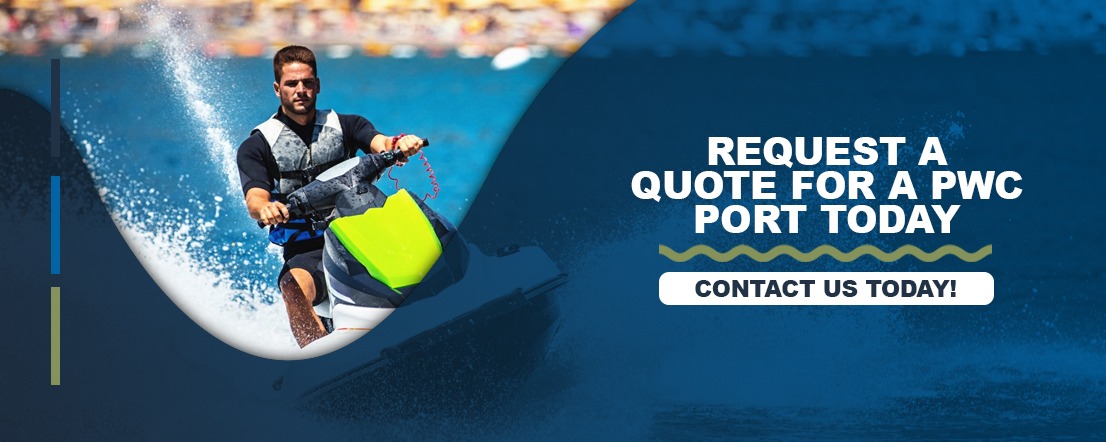Filters
7 Things You Should Know About Riding PWCs
With more than one million registered vessels across the country, riding a personal watercraft (PWC) is one of the most popular recreational activities in the United States. In addition to being a lot of fun, PWCs are very beginner-friendly. However, while operating a PWC is fairly straightforward, there are some important things you should know before you head to the lake or river.
To make the learning curve a breeze, we’ve compiled a brief guide about how to ride a Jet Ski for beginners.
Read the full article or jump to a specific section:
- How to Ride a PWC
- What to do if You Fall Off a PWC
- How to Ride a PWC with a Passenger
- What Do You Need to Jet Ski?
- Safety Tips for Operating a PWC
- Benefits of Using a PWC Port
How to Ride a PWC
Riding a PWC can be an exhilarating experience — especially when you hit your first wave. If you’re new to PWC ownership, here are some basic operating instructions:
- When sitting on your PWC, your feet should rest comfortably against the footrests, and you should be able to reach the handlebars with ease. Attach the safety lanyard around your wrist.
- Using the key attached to the safety lanyard, turn your PWC on.
- Slowly push the throttle and maintain a slow speed until you are a safe distance away from the shore or dock.
- Once you are in the open water, gradually increase your speed. As you navigate the water, be aware of your surroundings in front of, behind and on each side of your PWC.
- When driving in a straight line, release the throttle so you can take turns easily. Keep all accelerations and movements fluid.
- When turning, you and any passengers should lean in the direction you want to go. For tight turns, remember to maintain a steady acceleration. While doing this, be sure to center and balance the load weight on your PWC to avoid capsizing.
- Keep an eye out for marked no-wake zones. While in these areas, do not accelerate your PWC. Instead, idle until you are outside of the no-wake parameters.
- As you encounter waves, keep a firm grip on the handlebars and lift your body slightly to brace yourself.
You may need to alter your speed or navigation during certain circumstances, such as inclement weather or low light.
What to Do If You Fall off a PWC
One of the most important beginner tips for riding a Jet Ski, Sea-Doo or other PWC is to know what to do if you fall off your vessel. Although modern-day PWCs have built-in safety features that make it easier to stay on board, it’s better to be prepared for every possible scenario.
If you fall off your PWC, follow these steps:
- Always attach the safety lanyard to your wrist before starting your PWC. This way, should you fall off, the key will dislodge from the ignition and turn the PWC off.
- If capsized, follow the instructions listed on the back of your PWC to flip it. When flipping your vessel, turn it in one direction only.
- Once your PWC is facing upright, swim to the back of the vessel. Avoid climbing back on from the side, as this could cause the PWC to roll back over onto you.
- Climb aboard the PWC using the built-in back handles, the backloading platform or a built-in ladder, if applicable. Because both you and the vessel will be wet, it’s important to maintain a firm grip.
- While carefully balancing your body weight to avoid tipping, re-straddle the seat and return to your original position.
If, at any point during this process, you feel unsafe or incapable of reboarding your PWC, blow your emergency whistle.
How to Ride a PWC With a Passenger
If riding with a passenger, the person with the most experience operating a PWC should drive until each person is more familiar with navigating the water safely. Before the passenger boards, the driver should first position themselves until they are sitting comfortably. Once the driver is ready, the passenger should carefully straddle the seat behind them and wrap their arms around the driver’s waist. The passenger should maintain a secure hold, but avoid squeezing the driver too tightly.
It’s vital that the driver and passenger can communicate while on the water, so they can inform one another of any emergencies or give warning before turning the vessel. To ensure the safety of all involved, the passenger should always face forward, and both the driver and passenger are required to wear a life jacket.
What Do You Need to Jet Ski?
Because your PWC is essentially a small boat, there are a few things you should always have on board, including:
- Life jackets for both you and your passenger
- Water-resistant sunscreen
- Sunglasses
- A PWC anchor
- A lanyard with an attached whistle — this is separate from the safety lanyard
- A Coast Guard-approved fire extinguisher
- Your PWC registration number
- Mirrors, if towing anyone behind you
- A form of self-identification
- A dry bag or box to keep belongings
- A swimsuit or wetsuit
- A large beach towel
- An attached ladder
While many of the above objects will enhance your ride and help you stay comfortable, some might be required by law, depending on where you live. Always check with local rangers or Coast Guard personnel for guidance.
Safety Tips for Operating a PWC
Operating and riding a PWC is a great way to spend a warm, summer day — but never forget that you are driving a powerful machine. You must practice safe driving techniques and remain aware of your surroundings at all times.
To ensure the wellbeing of you, your PWC and your passengers, always abide by these safety tips:
- Never operate a PWC under the influence of drugs or alcohol.
- Always abide by all posted speed limits.
- Be aware of your surroundings when sharing the water with boaters, kayakers, paddlers and swimmers.
- Do not attempt to ride your PWC with multiple passengers.
- Never drive your PWC after sunset, especially when boating on unfamiliar waters.
- Children under the age of 16 should not drive a PWC.
- Take a boating safety course to learn the various rules and regulations associated with operating a PWC in your area.
Benefits of Using a PWC Port
If you’re a proud PWC owner, you understand how important it is to have a safe and secure place to dock your PWC when it’s not in use. A PWC Port from EZ Dock is the best way to protect your vessel.
With an EZ Dock PWC Port, you will enjoy the following benefits:
- Launching and re-entering the port is a breeze: With traditional ports or docks, launching your PWC can be time-consuming and a challenge for beginners. Thanks to our adaptable roller design, it’s easier than ever to launch your vessel into the water. After a long day spent on the water, docking your PWC shouldn’t be a hassle. That’s where the patented EZ Dock system is there to help once more, making it quick and simple to dock your PWC.
- They are easy to clean: A PWC Port from EZ Dock looks sleek, and it’s easy to keep it that way. Each port is crafted out of polyethylene, which is easy to clean with a pressure washer or EPA-safe cleaning solutions. Unlike traditional docking systems, you will never need to worry about splintering, rotting, rusting, warping or fading. Our PWC Ports are virtually maintenance-free.
- They are long-lasting: Polyethylene is a durable material, and very resistant to damage caused by collision or inclement weather. These floating docks also move with the water, protecting them from crashing waves or strong wind.
- You have several options: With EZ Dock, you can choose the PWC Port that fits your specific needs. For example, the EZ Port® VXP is ideal for small PWCs under 1,300 pounds, while the EZ Port MAX system is designed for flexible customization and to hold multiple PWCs at once. The EZ Port® 2i is an industry-leading split-entry port, perfect for any PWC. In addition, the EZ Port 280 has a widebody design to make loading and unloading simple.
Request a Quote for a PWC Port Today
At EZ Dock, we are passionate about creating products that are relentlessly durable and easy to use from boat ports to an array of dock accessories. Visit us online to request a quote for your new PWC Port, or contact one of our helpful representatives to learn more about which of our EZ Dock products is right for you.













